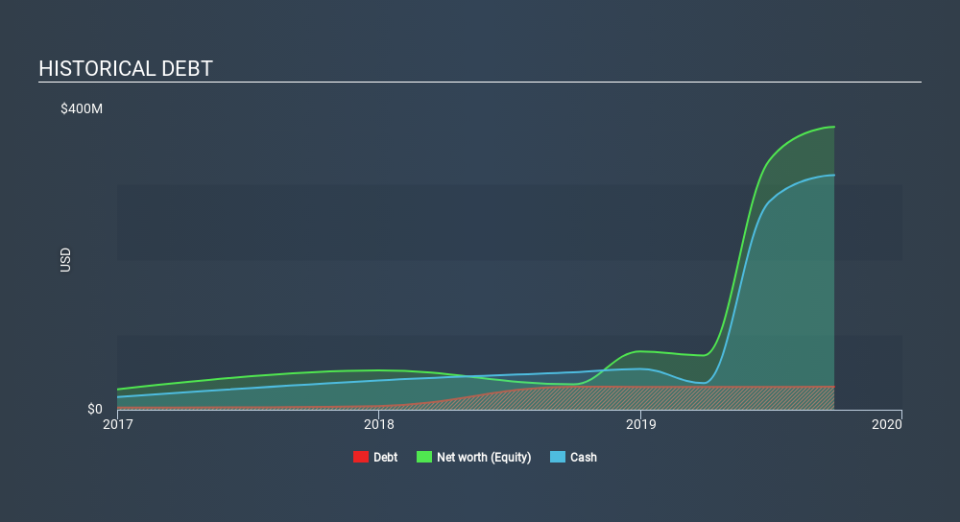Does Beyond Meat (NASDAQ:BYND) Have A Healthy Balance Sheet?

Some say volatility, rather than debt, is the best way to think about risk as an investor, but Warren Buffett famously said that 'Volatility is far from synonymous with risk. So it seems the smart money knows that debt - which is usually involved in bankruptcies - is a very important factor, when you assess how risky a company is. We can see that Beyond Meat, Inc. (NASDAQ:BYND) does use debt in its business. But the real question is whether this debt is making the company risky.
What Risk Does Debt Bring?
Debt is a tool to help businesses grow, but if a business is incapable of paying off its lenders, then it exists at their mercy. In the worst case scenario, a company can go bankrupt if it cannot pay its creditors. However, a more common (but still painful) scenario is that it has to raise new equity capital at a low price, thus permanently diluting shareholders. By replacing dilution, though, debt can be an extremely good tool for businesses that need capital to invest in growth at high rates of return. The first thing to do when considering how much debt a business uses is to look at its cash and debt together.
View our latest analysis for Beyond Meat
How Much Debt Does Beyond Meat Carry?
As you can see below, Beyond Meat had US$30.5m of debt, at September 2019, which is about the same the year before. You can click the chart for greater detail. But it also has US$312.5m in cash to offset that, meaning it has US$281.9m net cash.
A Look At Beyond Meat's Liabilities
According to the last reported balance sheet, Beyond Meat had liabilities of US$56.2m due within 12 months, and liabilities of US$21.8m due beyond 12 months. Offsetting this, it had US$312.5m in cash and US$34.5m in receivables that were due within 12 months. So it can boast US$268.9m more liquid assets than total liabilities.
This short term liquidity is a sign that Beyond Meat could probably pay off its debt with ease, as its balance sheet is far from stretched. Succinctly put, Beyond Meat boasts net cash, so it's fair to say it does not have a heavy debt load! There's no doubt that we learn most about debt from the balance sheet. But ultimately the future profitability of the business will decide if Beyond Meat can strengthen its balance sheet over time. So if you're focused on the future you can check out this free report showing analyst profit forecasts.
Over 12 months, Beyond Meat reported revenue of US$231m, which is a gain of 241%, although it did not report any earnings before interest and tax. When it comes to revenue growth, that's like nailing the game winning 3-pointer!
So How Risky Is Beyond Meat?
Statistically speaking companies that lose money are riskier than those that make money. And the fact is that over the last twelve months Beyond Meat lost money at the earnings before interest and tax (EBIT) line. And over the same period it saw negative free cash outflow of US$54m and booked a US$19m accounting loss. But the saving grace is the US$281.9m on the balance sheet. That kitty means the company can keep spending for growth for at least two years, at current rates. Importantly, Beyond Meat's revenue growth is hot to trot. High growth pre-profit companies may well be risky, but they can also offer great rewards. For riskier companies like Beyond Meat I always like to keep an eye on whether insiders are buying or selling. So click here if you want to find out for yourself.
Of course, if you're the type of investor who prefers buying stocks without the burden of debt, then don't hesitate to discover our exclusive list of net cash growth stocks, today.
If you spot an error that warrants correction, please contact the editor at editorial-team@simplywallst.com. This article by Simply Wall St is general in nature. It does not constitute a recommendation to buy or sell any stock, and does not take account of your objectives, or your financial situation. Simply Wall St has no position in the stocks mentioned.
We aim to bring you long-term focused research analysis driven by fundamental data. Note that our analysis may not factor in the latest price-sensitive company announcements or qualitative material. Thank you for reading.

 Yahoo Movies
Yahoo Movies 

